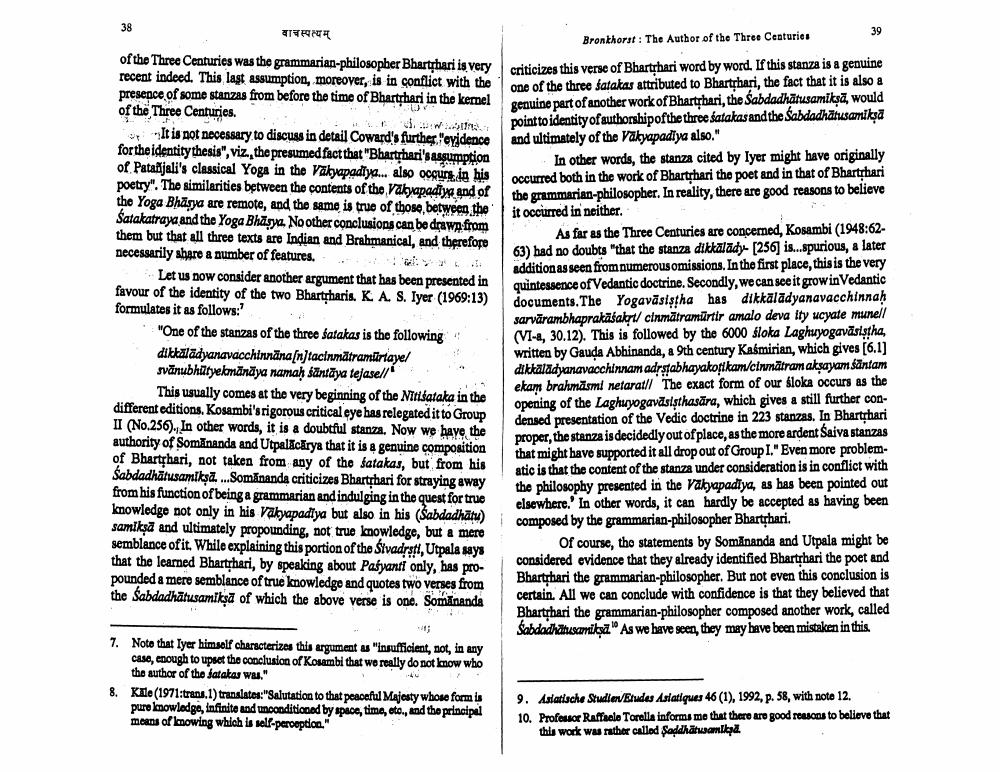________________
वाचस्पत्यम्
39
of the Three Centuries was the grammarian-philosopher Bharthari is very recent indeed. This last assumption, moreover, is in conflict with the presence of some stanzas from before the time of Bhartharl in the kernel of the Three Centuries.
It is not necessary to discuss in detail Coward's further "evidence for the identity thesis", viz., the presumed fact that "Bharthari's assumption of Patanjali's classical Yoga in the Väkyapadiya... also occurs in his poetry". The similarities between the contents of the Vakyapadiya and of the Yoga Bhärya are remote, and the same is true of those between the Satakatraya and the Yoga Bhagya No other conclusions can be drawn from them but that all three texts are Indian and Brahmanical, and therefore necessarily share a number of features.
Let us now consider another argument that has been presented in favour of the identity of the two Bhartharis. K A. S. Iyer (1969:13) formulates it as follows:
"One of the stanzas of the three satakas is the following dikkaladyanavacchinnāna [n]tacinmātramürayel svānubhütyekmänāya namah sāntāya tejasel'
This usually comes at the very beginning of the Nitisataka in the different editions, Kosambi's rigorous critical eye has relegated it to Group II (No.256). In other words, it is a doubtful stanza. Now we hayo the authority of Somānanda and Utpalācārya that it is a genuine composition of Bharthari, not taken from any of the Satakas, but from his Sabdadhātusamikșa....Somānanda criticizes Bharthari for straying away from his function of being a grammarian and indulging in the quest for true knowledge not only in his vakyapadiya but also in his (Sabdadhātu) samlkşā and ultimately propounding, not true knowledge, but a mere semblance of it. While explaining this portion of the Sivadrsti, Utpala says that the learned Bharthari, by speaking about Pafyant only, has propounded a mere semblance of true knowledge and quotes two verses from the Sabdadhātusamiksā of which the above verse is one. Somānanda
Bronkhorst: The Author of the Three Centuries criticizes this verse of Bhartrhari word by word. If this stanza 18 a genuine one of the three fatakas attributed to Bharthari, the fact that it is also a genuine part of another work of Bharthari, the Sabdadhātusamikṣā, would point to identity of authorshipofthe three satakas and the Sabdadhatusamiksa and ultimately of the Vakyapadiya also."
In other words, the stanza cited by Iyer might have originally occurred both in the work of Bharthari the poet and in that of Bhartshari the grammarian-philosopher. In reality, there are good reasons to believe it occurred in neither.
As far as the Three Centuries are concerned, Kosambi (1948:6263) had no doubts "that the stanza dikkalady [256] is...spurious, a later addition as seen from numerous omissions. In the first place, this is the very quintessence of Vedantic doctrine. Secondly, we can see it growin Vedantic documents. The Yogavāsiştha has dikkalādyanavacchinnah sarvärambhaprakāšakyt/ ctnmātramūrtir amalo deva ity ucyate munell (VI-a, 30.12). This is followed by the 6000 sloka Laghuyogavāststha, written by Gauda Abhinanda, a 9th century Kasmirian, which gives [6.1) dikkaladyanavacchinnam adrstabhayakori kam/cinātram aksayam santam ekam brahmäsmi netarat/ The exact form of our Sloka occurs as the opening of the Laghuyogavasişthasāra, which gives a still further condensed presentation of the Vedic doctrine in 223 stanzas. In Bharthari proper, the stanza is decidedly out of place, as the more ardent Saiva stanzas that might have supported it all drop out of Group I." Even more problematic is that the content of the stanza under consideration is in conflict with the philosophy presented in the Vakyapadiya, as has been pointed out elsewhere.' In other words, it can hardly be accepted as having been composed by the grammarian-philosopher Bharthari.
Of course, the statements by Somānanda and Utpala might be considered evidence that they already identified Bharthari the poet and Bharthari the grammarian-philosopher. But not even this conclusion is certain. All we can conclude with confidence is that they believed that Bharthari the grammarian-philosopher composed another work, called Sabdadhathusamiksa." As we have seen, they may have been mistaken in this.
7. Note that Iyer himself characterizes this argument u "insufficient, sot, in any
caso, enough to upset the conclusion of Kosambi that we really do not know who
the author of the satatas was." 8. Kate (1971:trans.1) translates:"Salutation to that peaceful Majesty whose form is
puro kowledge, Infinito and unconditioned by space, time, cto., and the principal means of mowing which is self-perception."
9. Asiatische StudievBludes Asiatiques 46 (1), 1992, p. 58, with note 12. 10. Professor Raffaele Torella informs me that there are good reasons to believe that
this work was rather called Saddhātuamikpl.




